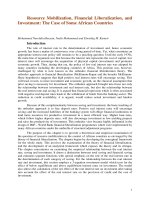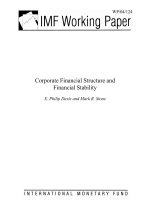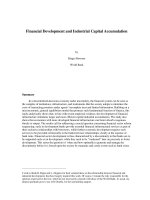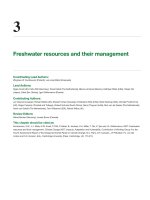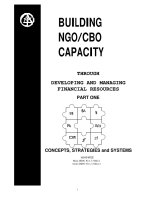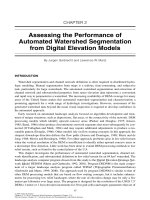Managing financial resources and decisions assignment 1
Bạn đang xem bản rút gọn của tài liệu. Xem và tải ngay bản đầy đủ của tài liệu tại đây (190.81 KB, 29 trang )
Outcome Failed: 1c; 2a
KMPG
Prepare for: Mr. Jun Bathan
Unit 2: Managing financial resources and decisions
Banking Academy, Hanoi
BTEC HND in Business (Finance)
Words: 4,225
Prepared by: Trần Anh Tuấn – Brad – F04-186
Registration no: F04-186
Submission date: 9th March 2012
1
Outcome Failed: 1c; 2a
Executive Summary
Financial sources are very important to a business. Knowledge about managing financial sources
will help a business to select appropriate sources and use them wisely. There are various types of
financial sources, and each one has advantages and disadvantages. A business has to assess the
advantages, disadvantages and has to calculate and compare the costs of different sources in
order to choose suitable sources. This report will show understanding about the issues that
relevant to sources of finance.
The report contains six main parts: Available sources of finance to business and the implications
of different sources, appropriate sources of finance for a business project, costs of different
sources of finance, the important of financial planning, the information needs of different
decision makers and the impact of finance on financial statements.
First part will indentify the available sources of finance to General Electric (GE) and assess the
implications of different sources.
Second part will indentify appropriate sources of finance for a GE’s project.
Third part will assess and compare the costs of different sources of finance.
Fourth part explains the important of financial planning.
The fifth part describes the information needs of different decision makers.
The sixth part shows the impacts of finance on financial statements.
2
Outcome Failed: 1c; 2a
Table of Contents
3
Outcome Failed: 1c; 2a
INTRODUCTION
Aims, Purposes/ Scopes
The aim of this report is the practice of identifying available sources of finance and
assessing the implications of each source, thus calculating and comparing the costs of each
source in order to choose the suitable sources for a business. The scopes of the report are:
Available sources of finance identification and implications assessment
Appropriate sources of finance for a business project
Costs of different sources of finance
The important of financial planning
The information needs of different decision makers
Impacts of finance on financial statement
Sources of information
This report uses the information from reliable sources: course book (BPP Professional
Education), websites like: BusinessFinance.com, Oxford dictionaries, and personal knowledge
and experiences.
Limitation of the report
Due to the limitation of the number of words, the report might not cover enough all
knowledge that relevant to sources of finance. Unimportant mistakes might occur.
4
Outcome Failed: 1c; 2a
1. Available sources of finance for General Electric and the implications
assessment of each source.
1.1 Overview of GE
General Electric (GE) is one of the largest industrial firms in the world. GE’s products are
diverse, from light bulb to air craft engine. With over 300,000 employees worldwide, GE’s
annual sale is over $180 billion. To a huge company like GE, finances are very important
because it needs a lot of money to keep the work going.
Financing is the backbone of a business, especially to a giant like GE. Finances are
divided into three types: Long and short term finance; external and internal; equity and debt. To
make it easy to identify available sources and asset them, debt and equity finances will be
analyzed.
1.2 Debt Financing
Debt financing is financing a company by selling the bonds, notes or mortgages held
by the business. Basically it is borrowing money to keep your business running
(BusinessFinance.com, 2012).
Advantages:
Initiative: A company will pay the interest and loan in a proactive way because
the interest rate is set at first.
Maintain ownership: The obligation of the company is to pay the debt fully on
time. The lenders cannot interrupt the company’s operation. Maintaining ownership is the key
5
Outcome Failed: 1c; 2a
factor to large companies, included GE. The dilution in control is not good in a big organization;
the company might turn into chaos.
Tax deduction: Tax deduction is considered as financial leverage. The tax is
counted in the formula: Tax = (sales – costs)* tax rate. Higher the costs or debt the lower
company has to pay for the government. With the huge sales amount of GE, the tax they have to
pay is huge. Therefore, this advantage of debt financing must be exploited thorough.
Disadvantages:
Risk: Companies have to face risks when they decide to use financing. When a
company goes bankrupt, it has to fulfill its obligation to lenders before dividing equity to owners.
With huge sum of loans, GE has its own risk. This risk must be controlled in order to calm the
investors.
High rate: Company has to face high interest rate even when the burden of tax is
reduced. The interest rates will base on the business’s condition, credit rating, history of credit
with banks. GE has the advantages because it is a large company with operating experiences so
its credit rating is high. This advantage helps GE get the loans easier with lower rates compared
to others.
Influences credit rating: It seems attractive for the company to keep carrying
debt during operating. However, each debt will be marked in the credit rating of the company. In
addition, the amount of the loans is proportional with the risk of the lenders and the interest that
the company must pay. In 2009, due to the global financial crisis, the credit rating of GE has felt
from AAA to AA+. GE must have solution to react to the unbalance in credit rating.
6
Outcome Failed: 1c; 2a
Cash and collateral: A company has to make sure that it has the ability to pay the
interest in the payment term. In addition, the company might have to mortgage assets for the
loans.
Table 1: Some types of Debt financing and its applications to GE
Types of
finances
Working
capital
loans
Main features
Short-term, used for day by day operating
Most banks provide these against collaterals
Businesses are supervised and have to follow
payment term strictly
Overdraft Short-term, the amount is limited due to the
agreement between banks and businesses.
Businesses do not need to report to banks
before using money and only have to pay
interest for the time they use it
Factoring Business transfer receivable accounts and
D
responsibilities to collect from the party who
E
owes money to banks
B Commercia It is a debt instrument issued by companies at a
T
l Papers
discount on the face value. Banks, individuals
(CPs)
and mutual funds usually buy commercial
F
papers (MaxAbout.com, 2008)
I
N
A
Term loans Long-term (normally 3-10 years). Used to buy
C
assets or expanding business. The amount,
E
term, interest rate depend on the risk profile of
S
business. Term loans might be asset-backed or
cash-flow backed. Methods to guarantee the
safety of the loans are different for each type
and are done by banks.
Syndicated Large capital loans
loans
Mobilize from group of banks (one bank lead)
Project
Finance
Project finance are either debt and equity
Huge amount, long-term
Using for infrastructure projects.
Sensitive to policies, tariffs and regulatory
Apply to GE
Using for purposes: buying
raw materials, paying wages,
funding operation and other
administrative expenses
To attend to day to day
operation
Serve the sudden expense
incurred
When GE need capital
during operation process
To pay short-term debt
Implementing new projects
Buy assets
Open new branches
Expand product lines
When GE intend to acquire
potential companies in the
same industry.
Implementing infrastructure
projects such as expanding
grids
7
Outcome Failed: 1c; 2a
Debentures
Leasing
Long-term, issued by the company
Negotiate interest rate
Not shares
Raise capital for operation
Agreements between two parties. Lessee pay
lessor to use assets which can be equipments
or finances.
Two types: Operating and finances leases
Serve the demand for
equipments for short-term
project.
Serve the demand for capital
1.3 Equity Financing
Equity financing is the act of selling common stock or preferred stock to investors. This
is usually done through an underwriter called an investment banker. The company will give up
ownership equity in their business and the underwriter will be responsible for promoting and
selling them to the public (BusinessFinance.com, 2012).
Advantages:
No obligation: The firm does not needs to concern about loans and interests and
their payment terms. This helps reduce the risk of bankruptcy to a business, especially to GE.
Owner share risk: Larger the number of shareholders, lesser the risk is. In case
of bankruptcy, the damages will be shared to all shareholders. Risks are problems a company
must solve. Equity financing is a way to reduce risks. GE might use equity financing to reduce
risks as much as it can.
Not illegal if unpaid: Because shareholders are owners, they have to accept that
if the company cannot make profit so do them.
Disadvantages:
8
Outcome Failed: 1c; 2a
No tax relief: Opposite to debt financing, when a company choose to use equity
financing, it cannot deduct tax. Obviously a giant like GE does not want to face this
disadvantage.
Dilution of control: The number of shareholders proportional with the dilution of
control. Because owners have rights to take part in the development process of a business,
therefore, conflicts might happen between shareholders. GE has to make sure that the dilution of
control is under controlled in order to avoid conflicts.
Table 2: Types of equity financing and its applications to GE
Types of equity
financing
Retained Profit
Issue
Shares
Features
Obligations
to
compensate
shareholders for not investing it or
returning it as dividend.
Not necessary mean available cash
Indirect control from shareholders
Shares
Risks are shared.
(in
Shareholders = owners -> rights to
general) vote(only available to ordinary
shares)
Business can raise a lot of cash
Ordinary Business can avoid dividends
shares
High success rate of issue shares
Unsecured and no legal action if
unpaid.
No tax relief. Expected interest is
high
Dividends affect cash flow
Preference Fixed rate
shares
Unsecured
Dividends can be avoided
Reduce dilution of control
No legal action if unpaid
Return expected > Debentures
No tax relief
Apply to GE
A part of retained profit
might be kept for operation
purpose and other part turn
into dividends.
GE issue shares for capital
or cash demands
To make sure the company
has enough capital, issuing
ordinary shares is a must.
Helps GE share the burden
of risks.
An attractive alternative
form of finance for GE, the
company
can
defer
dividends without risking
its credit rating
9
Outcome Failed: 1c; 2a
There are three ways for a company to issue shares: Right issues, new issues of shares
and bonus issues.
Right issues: Company issues further shares, involves offering new shares. Price
of new shares is below market value. The issuing of new shares will affect on the shareholding of
current shareholder.
Advantages:
Simple and cheap compared to new issues of share
Choices are given to shareholders
Can raise large amount of capital
All gains from any investment will accrue to existing shareholders
(Education, 2004)
Disadvantages:
Not suitable for raising a small amount of capital
Existing shareholders might lose some controls due to the rights
selling of other shareholders
To a huge company like GE, right issue is an effective way to raise capital.
However, this method might foster dilution of control and unable for raising small amount of
money. GE must concern about this problem to decide when and how many to issue.
New issues of share: For the purpose issuing shares the first time to public.
Therefore, it will not be analyzed because GE had issued their shares the first time in 1907.
10
Outcome Failed: 1c; 2a
Bonus issues: an issue of additional shares to shareholders instead of a dividend,
in proportion to the shares already held (Press, 2012).
For GE, instead of dividends, the company can use bonus issues. However, bonus issue
is used when the leaders on GE are confident about the future of the company. In addition, bonus
issue reduce the market value of share, therefore, its liquidity is high only when market value is
high. At the moment, the value of GE stock is low so bonus issue is not a sound option.
Debt financing and Equity financing are two sources of finance a company use during
operation. They both have pros and cons and each type of finances are used for different
economic purpose in different moments. GE must consider about what type and when to use to
acquire the effective.
2. Appropriate sources of finance for a business project
For a giant like GE, choosing appropriate sources of finance for a business project (example: a
two billion US Dollar project) is very important. There are debt financing and equity financing and both
of them have advantages and disadvantages. The mix of debt financing and equity financing will exploit
the maximum advantages and decrease the disadvantages for GE. However, to find out the appropriate
ratio between debt and equity financing, GE has to calculate WACC.
After calculating (Appendix I), there are three options for GE:
Using 16.16% debt financing and 83.84% equity financing
Using 50% debt financing and 50% equity financing
Using 83.84% debt financing and 16.16% equity financing (most suitable)
11
Outcome Failed: 1c; 2a
Methods
16.16% debt,
83.84% equity
50% debt,
50% equity
83.84% debt,
16.16% equity
Advantages
Reduce the burden of
paying interests
Huge amount of cash could
be raised in short period of
time
Create balance between debt
and equity
Average amount of tax
deduction
Large amount of tax
deduction
Reduce the dilution of
control
Disadvantages
Create high dilution of
control
WACC
4.528%
Dilution of control still
occur
2.766%
Very risky
1.004%
Using 83.84% equity can raise huge amount of cash in short time and alleviate the burden
of paying interests for loans. However, this leads to the changes in the proportion of shares
which will cause dilution of control. GE is a huge corporation. The dilution of control might lead
to the deviation in the development of the corporation. Therefore, using 83.84% equity
financing is not an ideal option for GE.
Using 50% of each method will create the balance in the advantages and disadvantages.
The increase in the amount of debt financing will increase tax reduction. However, the dilution
of control still occurs in this option. Therefore, using 50% of each method is not suitable for
GE.
The last option: 83.84% debt financing and 16.16% equity financing, which has the
smallest WACC (1.004%). In this option, GE will have a huge amount of tax reduction. In
addition, they can reduce the dilution of control. Besides, GE is a famous corporation so it will
not be hard for them to get loans. However, this option is very risky. In general, using 83.84%
debt financing and 16.16% equity financing is the most suitable option because it has the
lowest WACC and it can reduce the dilution of control, which is the most important factor for
GE in the current situation.
12
Outcome Failed: 1c; 2a
3. Costs of Different Sources of Finance
There are three sources of finance that GE needs to assess and compare the cost: Share
capital, Borrowed Funds and Retained Earnings.
3.1 Share Capital
Dividends in Cash: A cash dividend is a cash payment that is extended to shareholders
by the issuing company (wiseGEEK, 2012). In the case of preference shareholder, they have the
priority to get the dividend before ordinary shareholder, and the amount of dividend they get is
fixed. Preference share will guarantee the safety for investors. However, preference shareholder
cannot receive more when GE makes a lot of profit. Investor has to concern about the tax
problem because the tax level applied on GE is high (35%).
Scrip Dividend: Instead of paying dividend in cash for shareholders, the organization
can offer more share for them. This method will help the business to save cash for further
growing.
Besides, there are other costs such as consultant fees, stockbrokers or information
providing fees.
3.2 Borrowed Funds
Interest: Loans involve with interest. Currently, the interest rate of US is 0.25% (FED,
2012). Low interest rate will encourage businesses to borrow. This brings advantages for GE if
they choose to use 83.84% debt financing. Interest rate could be fixed and variable. However,
businesses prefer fixed rate loans so they could manage their payment easier.
13
Outcome Failed: 1c; 2a
Tax relief: Amounts that can be deducted from a person/organization annual income to
reduce the amount on which tax is paid (Relief, 2012). This is an advantage of using debt
financing
The other costs for borrowed funds are: opportunities cost, administration fees, audit,
initial arrangement commissions and so on.
3.3 Retained Earnings
Retained earnings are the profits generated by a company that are not distributed as
dividends to the shareholders. The retained earnings are the sum of profits that have been
retained by a company since its inception (AuditIT, 2012). The more dividend shareholders
receive the less retained earnings. Therefore, managers of GE have to adjust these two factors so
they could make shareholders happy and ensure that the corporation has enough finance for
future development. Opportunities cost is an important factor in Retained Earnings. Retained
Earnings could be for investments so they could make more profit for shareholders, or it could be
used to upgrade equipments and facilities. If Retained Earnings is used more on upgrading
facilities and investments and investments make profit, Opportunities cost will occur.
4. The Important of Financial Planning
Financial planning is the long-term process of wisely managing your finances so you can
achieve your goals and dreams, while at the same time negotiating the financial barriers that
inevitably arise in every stage of life. Remember, financial planning is a process, not a product
(FPA, 2012).
14
Outcome Failed: 1c; 2a
4.1 Sales Budget
Revenue earn
Cash sales
Credit sales
Cash collection
from
Same month
Previous month
Total cash
collection
Jan
100,000
40,000
60,000
Feb
120,000
48,000
72,000
Mar
160,000
64,000
96,000
Apr
140,000
56,000
84,000
40,000
48,000
60,000
108,000
64,000
72,000
136,000
56,000
96,000
152,000
40,000
(In USD)
4.2 Purchase Budget
Closing stock
Cost of sale
Peak inventory
level
Less opening
stock
Purchases
Cash
payment
Credit
payment
Jan
Feb
Mar
Apr
50,000
60,000
80,000
70,000
10,000
10,000
10,000
10,000
50,000
60,000
80,000
60,000
80,000
70,000
50,000
(In USD)
4.3 Personal Debt
Cost of sales
Wages
Fixed expenses
Variable
expenses
New equipment
Depreciation
Total
Jan
50,000
14,000
2,000
Feb
60,000
14,000
2,000
Mar
80,000
14,000
2,000
Apr
70,000
14,000
2,000
2,000
40,000
1,000
109,000
2,400
3,200
2,800
1,000
79,400
1,000
100,200
1,000
89,800
(In USD)
15
Outcome Failed: 1c; 2a
4.4 Capital Expenditure Budget
Asset
New equipment
1 cost
Cash payment
Credit payment
Jan
Feb
Mar
Apr
40,000
New equipment
2 cost
Cash payment
Credit payment
Total cash
payment
(In USD)
4.5 Cash Budget
Opening
balance
Total cash
receipt
Cash payment
DIRECT
OVERHEADS
INDIRECT
OVERHEAD
Total cash
payment
Surplus / Deficit
Add borrowing
Less repayment
Less interest
Closing balance
Jan
Feb
Mar
Apr
20,000
-66,000
-43,400
-15,600
40,000
108,000
136,000
152,000
109,000
79,400
100,200
89,800
17,000
6,000
8,000
19,000
126,000
-86,000
85,400
22,600
108,200
27,800
108,800
43,200
-66,000
-43,400
-15,600
27,600
(In USD)
4.6 Comment
The opening balance is the amount of funds in a company's account at the beginning of a
new financial period. It is the first entry in the accounts, either when a company is first starting
16
Outcome Failed: 1c; 2a
up its accounts or after a year end (E-economic, 2012). Because the company’s sales are 60% on
credit and payment term is 30 days so the opening balance of February, March and April were
minus. In January, the company only received 40% from sales in cash so the cash deficit was
-86000. On February, March and April, the credit from previous term was paid so cash surplus
were 22,600 (Feb), 27,800 (Mar), 43,200(Apr).
The company is growing. Therefore, the minus in opening balance is not worth worrying.
The company has the potential and it will affirm its ability in the future. This is an opportunity
for investors.
4.7 Profit & Loss budget from Jan-Apr
Revenue
Cost of sales
Add income
Accrued income
Less interest
Retained profit
520,000
260,000
(In USD)
4.8 Budgeted Balanced Sheet
Current Asset
Debtor
165,000
239,000
239,000
Trade creditors
Others
Net current Asset
207,000
Financed by
others
Net profit
Total equity
196,000
207,000
(In USD)
17
Outcome Failed: 1c; 2a
5. The Information Needs of Different Decision Makers
There are three main factors in using information: Type of information, classification of
user and the way information is analyzed. To serve the purposes of users, Information are
analyzed into two section Qualitative Assessment and Quantitative Evaluation.
5.1 Types of Information
Qualitative
Assessment
Type of
information
Cash position
and cash flow
Financing of
operations and
funds flow
Profitability or
earnings
achieved
Financial
position
Financial Risk
Quantitative
Evaluation
Segmented
information
The revenue
cycle
The
procurement
cycle
The production
cycle
The payroll
cycle
Features
Show the ability to pay accounts in payment term of a
company. Investors must concern about this.
Flows of cash and credit.
The interest return of investment. This information
Define how profitability a company is.
The status of the assets, liabilities, and owners' equity
(and their interrelationships) of an organization
(WebFinance, 2012).
The risk that a company cannot adapt the requirement
of cash for financial obligations
Information are specialize for each part of the
business
A revenue cycle is the process businesses use to
describe the financial progression of their accounts
receivables from the very beginning, when they first
acquire product, if they're product based, until they
get paid, if they get paid in full (eHow.com, 2012).
A process of procuring materials in order to ensure
the manufacturing is not interrupted.
Activities occur during operation, included:
production control, cost accounting, work in process,
inventories
The payroll cycle starts with hiring (and firing)
people and determining their wage rates and
deductions, then proceeds to attendance and work
(timekeeping), and ends with payment followed by
preparation of governmental (tax) and internal
reports. Some of the main payment cycle steps
include gathering employee time, running earnings
18
Outcome Failed: 1c; 2a
The financial
cycle
and deduction calculation and payment print
(USLegal, 2012)
Include economic activities related to banking,
investment, cash management
Table 3: Classification of information
5.2 Classification of Information User
Management: managers directly involve with day to day operation of a company.
Therefore, managers need the overview of financial situation of the company in order to make
the most profitable decision.
Employees: employees have high interest in the situation of a company because the
effectiveness of the operation affects directly to their wages and other entitlement. Employees
need to measure the stability of the company to ensure their jobs are guaranteed.
Creditors: Creditors need to know about credit history of a company to make wise
decisions. In case creditors are owed, they need to examine the capacity to pay when account are
mature.
Bankers and other lenders of money: concern about the repay ability and the stability
of a company.
Government offices: for taxes calculation purposes and for analyzing, collecting data,
statistics purpose.
Prospective investors in companies: for evaluating the financial situation of a company
to choose the most appropriate way of investment.
Customer: customers concern about the existence of a company to ensure they will be
able to buy more products and services in the future or the continuing of warranties.
6. The Impact of Finance on the Financial Statement
Finance has the major influences on the financial statement of a company. Finance is
considered as the backbone of the business. Without finances, the business will collapse.
19
Outcome Failed: 1c; 2a
Besides, the financial statement shows the performance of a business. Figures in the statements
are the bases for stakeholders to evaluate the situation of a company.
6.1 Control operations and earnings
Gross
margins
Average
2006
27.03%
2007
26.52%
2008
25.71%
2009
27.85%
2010
28.6%
27.14%
Table 4: Gross margins of GE in the period 2006-2010
The higher the percentage, the more the company retains on each dollar of sales to
service its other costs and obligations (ULC, 2012). Due to the global finance crisis, the gross
margins of GE felt to 25.71% in 2008. However, then trend was changing back up in the last two
years. This increasing shows the financial situation of GE is getting better recently. The growth
of retain on each dollar helps GE to reduce some burden of costs and obligations.
6.2 Assess Vendors, Customers and Business Partners
Business world is a place full of competitors. Therefore, it is very important to have
partnerships. Financial statement is a tool for business to evaluate their partners, to ensure their
relationships are stable. Examine relationships is necessary before making economic decisions.
Assessing financial statement is also the basic for choosing a potential partner or monitor
current partners. Because of the global financial crisis, the growth rate of GE has felt down
recently. However, this problem is just temporary. With the solid foundation, GE is a good
partner to corporate with.
GE is a multinational company so it has a lot of partners. Assessing vendors, customers
and business partners is important to GE. Bases on the figures of evaluations, GE is able to
manage the above factors.
20
Outcome Failed: 1c; 2a
6.3 Stability of Vendors, Customers, and Business Partners
The assurance of vendors, customers is directly affects the revenues of a company.
Evaluating the stability of vendors and customers will help a firm to make timely decisions if
problems happen.
The stability of partners is also important. A good partner is a financial leverage for a
company. In contrast, an unstable partner will slow the company down. To GE, its management
must consider about the stability of the company’s partner in order to decide to maintain the
relationship or not.
6.4 Assess Appearance to Investors and Creditors
A company is under the observed of many factors. That’s why a company must consider
about what they choose to show to those factors. The performance of a company is showed
through its financial statements such as cash flow. When looking into a company’s financial
statement, the viewers might misunderstandings the problem so they might cancel their
economic decision towards the company. Therefore, it is very important for a company to
distributing information to its stakeholders to avoid misunderstand problems.
GE is a giant so their acts are obviously to their stakeholders. Therefore, GE must be
really careful when it distributes its information. A mistake in a financial statement of GE might
cause a chain reaction, effect the operation of GE.
CONCLUSION
Finance plays an important role, it is considered as the backbone of a business, especially
for General Electric (GE). To be able to choose appropriate sources of finance, available sources
of finance must be identified, assessed and compared to point out the implications and the costs
of each source.
21
Outcome Failed: 1c; 2a
Besides sources of finance, financial planning is also important to a business. It helps
managers to manage the business’s finance effectively. Financial planning is showed through
budgets like (sales, cash, expenditure and so on).
Each decision makers need a different type of information to serve their personal purpose
(invest, manage, research and so on). GE has the obligation to provide full and truthful
information for users so they can make right decisions.
Finance is an important factor. Therefore, it will affect financial statements. Through
figures, financial statements will show the performance and the current situation of the business.
Decision makers could base on those figures in order to make appropriate decisions.
References
AuditIT, 2012. ReadyRatios: Retained Earnings. [Online] Available at:
[Accessed 7 March 2012].
BusinessFinance.com, 2012. Debt Financing-Business Finance. [Online] Available at:
[Accessed 6 March 2012].
BusinessFinance.com, 2012. Equity Financing - Business Finance. [Online] Available at:
[Accessed 6 March 2012].
Education, B.P., 2004. BPP Professional Education. 1st ed. London: Aldine House.
E-economic, 2012. What is the opening balance ? [Online] Available at: [Accessed 6 March 2012].
eHow.com, 2012. What is a Revenue Cycle? [Online] Available at:
[Accessed 6 March 2012].
FED, 2012. Board of Governors of Federal Reserve System. [Online] Available at:
[Accessed 7 March 2012].
FPA, 2012. What is Financial Planning?. [Online] Available at:
[Accessed 6 March 2012].
22
Outcome Failed: 1c; 2a
MaxAbout.com, 2008. Different Types of Debt Financing - Business & Finance. [Online] Available at:
[Accessed
6 March 2012].
Press, O.U., 2012. Oxford Dictionaries - The world's most trusted dictionaries. [Online] Available at:
[Accessed 6 March 2012].
Relief, T., 2012. Tax Relief: Defined. [Online] Available at: [Accessed 7 March
2012].
ULC, I., 2012. Gross Margin Definition. [Online] Available at:
[Accessed 6 March 2012].
USLegal, 2012. Payroll Cycle Law & Legal Definition. [Online] Available at:
[Accessed 6 March 2012].
WebFinance, 2012. What is financial postition ? [Online] Available at:
[Accessed 6 March 2012].
wiseGEEK, 2012. wiseGEEK. [Online] Available at: [Accessed 7 March 2012].
Appendix I - WACC Calculation
Asset
Total
assets
Liabilities
Owner’s
Equity
Total debt
and
equity
Rate of
Debt
financing
(%)
Rate of
Equity
financing
(%)
Average
of debt
2010
751,216
2009
781,910
2008
797,769
2007
795,683
2006
697,239
2005
673,231
627,018
124,198
656,765
125,136
684,157
104,665
672,120
115,559
577,347
112,314
555,916
109,351
751,216
781,910
797,769
795683
697,239
273,231
83.46
83.99
85.75
84.48
82.80
82.57
16.54
16.01
14.25
15.52
17.20
17.43
83.84
23
Outcome Failed: 1c; 2a
(%)
Average
of equity
(%)
16.16
(In millions USD)
Table 3: Some figures about GE financial situation
There are three methods to invest for GE:
Using 83.84% debt financing and 16.16% equity financing
Using 50% debt financing and 50% equity financing
Using 16.16% debt financing and 83.84% equity financing
Debt after tax cost (of GE): Rd = Rdt x (1 – t)
Rd: Debt after tax cost
Rdt: Interest rate taken from FED = 0.25%
t: tax rate = 35% (tax level applied on GE)
Rd = 0.25% x (1 – 35%) = 0.1625%
Cost of issuing ordinary shares: Rc = Dc / [Pc x (1 – ec)] + g
Notes: Dc : dividend per share = $0.15
Pc : value per share = $14.77
ec : assuming the flotation cost for ordinary share = 15%
g : earning growth projected at constant = 4.18% (Table 5)
Cost of issuing ordinary shares: Rc =0.15 / [14.77 x (1- 15 %)] + (4.18%) = 5.37%
Year
00
01
02
03
04
05
06
07
08
09
10
Items
Dividend 0.16 0.18 0.19 0.20 0.22 0.25 0.28 0.31 0.31 0.10
per share
A%
12.5%
B%
5.5%
C%
5.2%
D%
10%
E%
13.6%
F%
12%
G%
10.7%
H%
0%
I%
-67,7%
K%
40%
g
(A+B+C+D+E+F+G+H+I+K)/ 10 = 4.18%
0.14
Table 5: Dividend per share of GE in the period 2000-2010 and its constant earning growth
24
Outcome Failed: 1c; 2a
WACC = Wd*Rd+Wc*Rc
Methods
Assess
Using 83.84% debt
financing and 16.16%
equity financing.
Using 50% debt
financing and 50%
equity financing
Using 16.16% debt
financing and 83.84%
equity financing.
WACC
(83.84%*0.1625%) +
(50%*0.1625%) +
(16.16%*0.1625%) +
(16.16%*5.37%) =
(16.16%*5.37%) =
(83.84%*5.37%) =
1,004%
2.766%
4.528%
25
